Embedded Adventurism
Creative and professional class squatters are being lauded in The Financial Times as socially responsible agents of regeneration. Meanwhile, the UK’s market-driven housing crisis is making squatting more necessary and more insecure. Matthew Hyland analyses the changing social and political composition of squatting, and swings a wrecking ball at 5 1/2 Roofs, a recently released documentary ‘about’ squatters which claims to reveal a ‘rarely seen layer of London life’
Reports of the demise in the UK of Dutch anti-squatting racket Camelot Property unfortunately seem to have been premature. Some of the laminated signs with a picture of a castle, designating properties as 'protected by occupation', had disappeared lately, with dialectically-minded realtors opting for demolition as protection instead. It was even rumoured that the last few Camelot 'guardians' (i.e. people who pay an agency for the right to live in a squat-like building owned by a landlord who has paid the same agency to put them there) were huddled with their compulsory £50 health and safety packs in the last warehouse left to guard. But then Rupert Murdoch's The London Paper ran a feature in its real estate section promoting Camelot as an ideal interim solution for creative, adventurous young people and 'key workers'. That's right, key workers, the public-sector professionals who were supposed to receive the only state-subsidised housing still going, because their well-above-minimum wages would get them nowhere near the 'housing ladder' in inner London and aren't necessarily even enough to rent them 'decency' in the private sector.
Not only has Camelot not died then, its effrontery has reached a pinnacle from which it aspires to compete not just with private sector slum lords but also with a flagship government initiative aimed at an educated, middle-income vote. Yet the very fact that the institutional opportunists would try this move (and that it would be reported in a breezy, no-explanation-necessary way in a lifestyle paper) implies wide recognition that conditions have deteriorated to the point where demand for such a service could exist. If a squatting-substitution agency is targeting key workers, it goes to show that the emergency that makes squatting necessary, i.e. the reasonable expectation that finding even barely adequate housing by conventional means may simply be impossible, has spread so far as to engulf securely waged professionals enjoying special state protection. (In London officially 'affordable' housing is set aside for those with paltry incomes of under £50,000 per year [Mayor of London's free newspaper]. Average annual income of council tenants in the officially fashionable borough of Islington is under £5,000 [www.iwca-islington.org.uk/islington.htm].
The current London housing situation dramatises the class fracture between, on one side, those people who experience their 'choices' as based on tastes and desires, adventure and opportunity, and on the other those aware of reacting to material necessity and outside command, whether in forced acquiescence or costly refusal.[1] Squatting[2] is a practice of costly refusal[3] through which a few members of the commanded class try temporarily to bypass the rules of capitalist exchange by directly seizing use-values it denies them, i.e. housing. Like many other kinds of illegal or unlawful activity[4] the existence of squatting does nothing in itself to threaten the enforceable sanctity of ownership. But in a society where housing is one of the commodities used most aggressively by capital to claw back value (and hence also 'agency') from the working class, squatting represents an exceptional and hard-won downward transfer of wealth and of the elements of agency that follow from it. Unfortunately this partial reclaiming of agency also means some squatters tend to fall prey to dangerous (and characteristically 'middle-class') delusions of personal freedom.
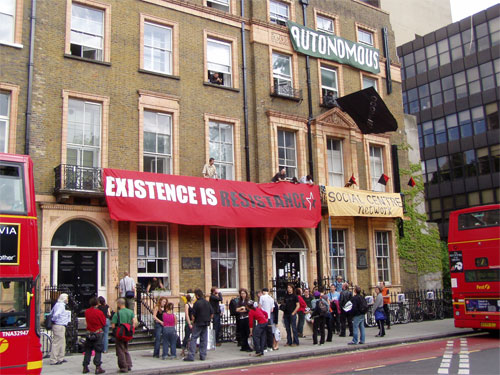 Image: The five month old squatted social centre at Russell Square, London
Image: The five month old squatted social centre at Russell Square, London
The recent documentary 5 1/2 Roofs by Sepp R. Brudermann is remarkable for its complete mystification of every aspect of this complex situation. Or perhaps the mystification is not quite so complete, as Delusions of personal freedom would make a perfect alternative title for the film. The delusions are given ample space to cavort in, complete with musical puppet theatre, it's just that they are never presented as delusional. And worst of all, a total lack of contextual specification means they're implicitly projected onto thousands of squatters who couldn't agree less.
It should be made quite clear at this point that the film makers' sincerity and commitment are not being called into question. 5 1/2 Roofs was screened and sold on DVD to raise money for Spirit Grant's fight for his home and livelihood against the regenerators of Broadway Market, and for the absolutely socially vital Advisory Service for Squatters. These contributions are unconditionally welcome.
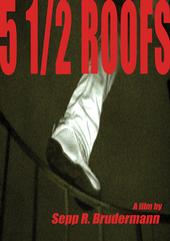
Image: Film poster for Sepp R. Brudermann's 5 1/2 Roofs
But all the good intentions in the world are no barrier to the disinformation that can issue from the coupling of technical expertise with a casual approach to subject matter. Perhaps Brudermann and colleagues would object that they weren't trying to make a statement about squatting in general, they only wanted to 'tell six stories about life in the city'. Yet the film's relentlessly intimate, personal approach to the featured squatters' leaves the declared theme of 'squatting' as the only unifying element, and this is precisely what makes it seem to set these lives up as paradigmatic of what Raindance festival publicity called 'a rarely seen layer of London life'. If any information distinguishing the housing situations in the six cases had been stated, the appearance of generalisation would have been avoided, and the particular stories would have been seen as just that. But no such details are given: 'squatting' remains a single, undifferentiated category unifying the episodes, defined only by being 'brought to life' through the personal experiences and psychodramas of the squatters who let the film crew into their living space.
The film-makers are anxious to show that not all squatters are criminal, drug addicted, disease carrying, Ecover resistant social stains. While anyone associated with squatting who is so cravenly eager to disown others' survival strategies should be driven with fire and sword up the teetering 'housing ladder' (it's next to the careers pyramid, around the corner from the grooming tree), it's true that this image of squatters has still not quite disappeared. But another stereotype is probably more persistent, especially among working-class renters and mortgagees: squatters as young opportunists with plenty of leisure and no rent to pay, playing around in damaged neighbourhoods, oblivious to the problems of the poor next door who pay in full. A cheap holiday in other people's misery, etc. In a few cases this characterisation may actually be true, although if so squatters like that amount to a mere shadow of the boho-gentrifying segment of the real estate market. More often though, economically embattled neighbours eventually notice that squatters are confronting privations similar to their own, whatever they think of the wisdom or the aesthetics of their approach. So it's unfortunate that refusal of the 'junkie-criminal-squatters' profile is as far as 5 1/2 Roofs gets in addressing issues around squatting in general. The film remains unconcerned with the second stereotype and its implications. Or rather it seems unconcerned except where, no doubt inadvertently, it cultivates the myth.

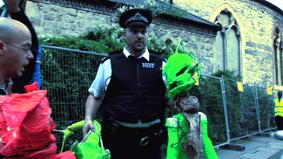
Images: Stills from Sepp R. Brudermann's 5 1/2 Roofs
The first part is the most astonishing in this respect. An opening subtitle states that occupying empty buildings is not illegal in the UK and that more than 13,000 people do it in London. (This is the only piece of generally applicable concrete information about squatting provided in the course of the six-part feature.) Then the first bunch of squatters appear, cycling around mock-Tudor mansions at night. The episode is entitled 'Minsk-London', so presumably they're from Belarus. (Any insight into non-EU East European migration vis-a-vis London work and housing/squatting would have been interesting, but there isn't any.) What's actually being introduced is not just the characters in the 'story', but also the director's style of embedded video journalism: no contextualising commentary, just 'participant-observer' camera running day and night as the characters fool around or ruminate existentially, with heavy, dramatic editing and soft Electronica soundtrack added later. There's no indication of where or when the squat (or any of the others shown) existed, but the group are seen sleeping, eating, showering and doing repairs: 'proudly' projecting what one of them calls 'a good image of squatting', nothing like the 'junkies and thieves' imagined by 'most of the people'. But there's already reason to suspect that these young people's true home is the statistical margin for error. The same interviewee says he squats for 'the way of life', but 'there's always an exit ... I know I could always go and rent ... it's a two-way street'. I could ALWAYS rent??!! Bear in mind that in London that would mean always having immediate access to a lump sum of several hundred pounds in advance rent and bond, well over £500 for a 'studio' (i.e. zero bedroom) flat, a bit less, if you're lucky, for a room in a house overcrowded with strangers, a bit less again if you're prepared to share the room. It's hard to imagine a worse way to illustrate the basic point that squatting and renting aren't lifestyle commitments at ideological war with one another. Certainly all kinds of people are repeatedly flung back and forth by circumstances between arrangements like squatting, 'social' tenancy, sub-'decent' market renting, sublets, institutional waiting lists, friends' floors and rough sleeping, but perhaps the one thing uniting all squatters (or almost all, it would seem) and the rest of the 'unfree' housing class is the knowledge of not having an 'exit' always available. Continuing to squat, continuing to be able to afford not to squat, and finding ways to pass from one condition to the other are all difficult, precarious processes. Dealing with these problems is a common feature of life in squatting's socio-economic environs. Little could be more alien to this world than freely choosing your direction on a 'two way street'.


Images: Stills from Sepp R. Brudermann's 5 1/2 Roofs
The grounds for the interviewee's confidence are revealed just after he says, 'look at us, we work nine to five!', when the group appear in an architecture studio, discussing 'cool' riverside apartments and 'hotel-style' flats for clients who only fly in from New York once every couple of weeks. Here again, an elementary point is made in such a contorted way as almost to imply its opposite. Perhaps it does need to be spelled out to some people that squatting doesn't mean never having to work again: aside from the spirit-breaking labour required to wrench benefits from the state, the thousands of squatters who need to hold down one or several jobs tend to find that the additional unwaged labour their living situation demands takes total working hours way beyond 'full time', while the competing claims on time of job(s) and squat create a real risk of losing both. But using a few elite professionals to show that not all squatters are genetically anti-social 'benefit thieves' not only reinforces stereotype 2 (the 'cheap holiday' one), it implicitly endorses the notion that this is what respectability looks like, an assumption which in turn confirms the 'degenerate' status of the remaining thousands of squatter-workers in less 'cognitive' jobs, as well as unemployed squatters and all the millions of non-squatting but legally marginal unemployed and/or working dirt poor.
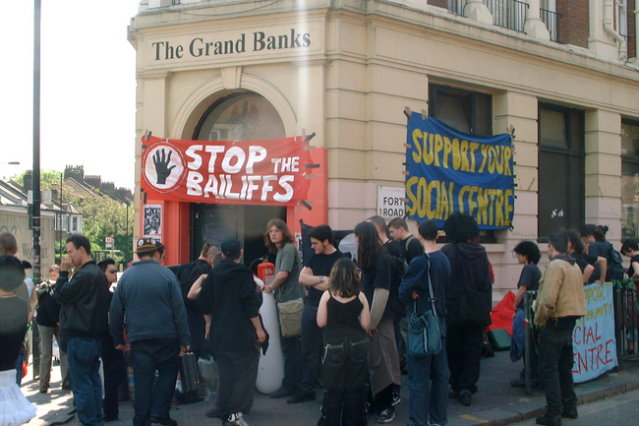 Image: The Grand Banks squatted social centre at Fortess Road, Tufnell Park, London
Image: The Grand Banks squatted social centre at Fortess Road, Tufnell Park, London
Then all of a sudden one morning, while the camera is running, the squat is broken into and evicted by the police, and everyone inside is arrested. The preceding italics are there because in real life this never happens without a particular, exceptional cause. But of course the intimate-embedded documentary style avoids explaining causes. This leads to mystification of crucial facts. What the 'squatting is not illegal' slogan actually means is that in legal terms squatting is a civil matter to be settled between owners and occupiers, and hence has nothing to do with enforcement of criminal law, i.e. the police's job. Under normal circumstances, landlords whose speculative space has been invaded can either pay lawyers and bailiffs to eject squatters legally and slowly, or they might hire freelance violence and intimidation to speed the process up. In the latter case they may have grounds for thinking the cops won't intervene to stop them just because some freshly homeless legal pedant says they have to. The one thing they can't do, though, – I've watched them try – is flag down a patrol car to get the interlopers off their property for free. Police will take action against squatters in only a few situations, and if the architects were caught up in any of these, the whole thing would have been crying out to be shown on film. Where there's evidence that criminal offences unrelated to the occupation itself – drug 'crime' and related 'anti-social behaviour' under 2003 legislation, but more commonly 'theft' of electricity or gas – cops sometimes collude with a council or other well-connected landlord to smash their way in, arrest everyone and hold them until the owner has taken vacant possession, without forgetting to destroy the squatters' chattels. (Visit Ashwin Street in Dalston to see a block of flats evicted this way in the late 1990s and still covered in wilting corrugated iron now: the council and police eventually let the evicted return to collect their 'shit' only after ensuring that it was covered, literally, in human shit.) The other reason the police get involved is when a court order to leave is deliberately ignored, and occupiers decide to defend a building physically. This was the case with the Broadway Market occupation also featured in the film and in many other well-known struggles including the defences of the 121 centre in Brixton and St Agnes Place in Kennington.[5]. However, it didn't seem to be what was going on here, not only because of how difficult it would be for film-makers to miss it – serious fortifications and mass physical mobilisation tend to be quite conspicuous – but also because when the cops are breaking through the door the one squatter who stands his ground does no more than repeat: 'guys... you can't do this... it's not right...'.
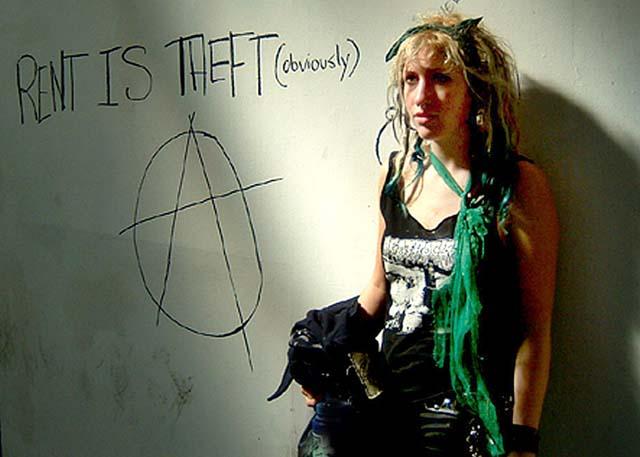
Image: A young Proudhonian
If this point is being belaboured here it isn't just for the sake of a laugh at the expense of helpless moralism, there's something more serious at stake. Squatting couldn't exist in its current form in the UK if it were criminalised as it appeared to be here, with unexplained summary eviction and the squatters held for 30 hours in police cells.[6] The film's failure to clarify the circumstances of this unusual attack risks making it look like something normal, a natural hazard of squatting, against which nothing can be done. And the effect is compounded by the fact that it's the first of three sudden evictions either shown or referred to in the film without further account of the particular situations in terms of law or physical force.[7]
Anyway, the camera cuts out, and the next scene is underwater in a swimming pool with the musical accompaniment of what sounds like digitally-enhanced harp, while a subtitle announces that after their unpleasant experience the squatters 'all decided to fly away on holiday' (weren't they supposed to be working nine-to-five?), after which 'they all quit squatting'. By this point, of course, it was clear that they'd been on holiday all along. This section of the film was instructive, although maybe not in the way intended. It demonstrated the truth of an axiom that directly links 'way of life' squatting to Camelot and the 'edgy'/'gritty'/'vibrant' part of the real estate market: all 'adventure' not driven by necessity is TOURISM. In case the point wasn't obvious enough already, the device linking each section of the film to the next is a shot from an aeroplane window, with blue skies, fluffy clouds and fluffier ambient Electronica.
The realities shown in the other parts of the film differ to varying degrees from that in the first vignette – the Broadway Market occupation was as different as could be, and the rampART social centre is different again – but the exclusive focus on personal, emotional drama means the material differences between the situations are never clearly established, so the creepiness of the first episode seems to pervade the rest. The segments on the two most 'creative' of the six squats bring out a related creepy element: the adventurer's idea that his or her lifestyle has something intrinsically socially valuable or even revolutionary about it, which 'straight' society just can't understand. Of course nonsense of this sort is heard from squatters from time to time in the unfilmed world, but can't be called characteristic, as the delusion is rarely able to withstand exposure to the practical reality of squatting for long. In the film, however, its ultimate meaning is brought out in a particularly obnoxious way by Bob, an older resident of the second squat, the Circle Community Centre/St George Theatre in Tufnell Park, which is already being evicted without explanation when it's first shown. Bob has something which the younger people being evicted with him will never be offered: a council flat. (You wouldn't know it from the film, but the elimination of council housing even as a realistic long-term option, other than for the severely disabled and the most prolific breeders, is an important cause of the current over subscription of London's squatting stock). If he had kept his mouth shut, Bob might have appeared admirable for keeping his flat out of the private sector while squatting for the sake of conviction, friendship or whatever. To his credit he's the only person seen angrily denouncing the fact that people are kept out of 'perfectly adequate' housing because they can't afford it. Unfortunately, however, he allowed himself to be interviewed on the subject of why he doesn't take advantage of his secure tenancy. Bob hates living on a council estate because he doesn't like council tenants. 'Regrettably', he says, he is surrounded on the estate by 'people who don't want anything to do with each other. I see the way they behave, I hear the tones of the voices ... deliberate avoidance of eye contact ... I've got no idea who my next door neighbour is ... It's just not a righteous way to live.' From a 'righteous' point of view, in other words, the problem with council estates is anti-social behaviour.
For such lifestyle avant gardists, squatting means getting away from the actually-existing working class in order to embrace 'creativity', such as puppet theatre and Electronica. Any squatters who do think this way are already riding the Camelot-Foxtons aspirational conveyor belt. (One of the predatory developers of New York's Lower East Side in the 1980s famously thanked 'the squatters' for 'opening up' what used to be a Hispanic and black workers' neighbourhood). But what's infuriating about the film is its failure to establish clearly that this attitude is not the norm among squatters, not because they're more community-minded or ideologically insightful than anyone else, but for straightforward practical reasons. Most squatters are residents of ex-/council estates or other working-class areas, and rather than wanting to get away from their neighbours, they share with them the need to defend their housing arrangements, income sources and relative, imperfect 'freedoms' against converging state and private sector attack. If anything, squatters' vulnerability makes them even more dependent on nearby tenants' acknowledgement of common interests. Failure to work at maintaining this goodwill tends to cut experiments in squatting very short, notwithstanding the survival of a few hippy misanthropists (who often turn out to have back-up housing options).
Misanthropy is just what lifestyle evangelism combined with universal sociability (eye contact and first name greetings or else you're anti-social, etc) stinks of. It reappears in a different way in the next section of the documentary, with Shiva, apparently the spokesman for Urban Nomads (maybe an artists' collective? it's not made clear of course). On 'an earth contaminated and polluted by human endeavour', the Urban Nomads are an Elect fraction, 'ready for economic and ecological change'. Yet the Elect programme is good for everyone, whether we know it or not. Whatever their race or background, people who come to the squat will find out that they're 'just like' one another. 'Assimilation' is a word Shiva repeatedly uses in a positive sense. This attitude to humanity in general reappears on a different scale in a remarkably frank avowal of what Félix Guattari would have called personal 'micro fascism', an all-too-common phenomenon within squatting. Shiva starts saying something about 'what I'm trying to do' with the squat, then quickly adds: 'when I say 'I', it includes the whole group'. What he wants is for their benefit too. This is the terrifying sincerity of micro fascism, the passionate presumption to 'help' others, to want things for them.
During most of the interview, Shiva's two or three year-old(?) child is screaming, 'NO!NO!NO!NO! DON'T TALK!!'. So he starts talking about the child and its future, and in doing so enthusiastically endorses squatting's most depressing potential. The boy's mother, says the father, is 'very proper, very middle class, a nice house, but(!) she's also a naturopath, a homeopath, a doctor', and at the squat the kid gets to run around amid garrulous chaos. 'So my son will have the best of both worlds: East and West, assimilation from both sides.' Leaving aside that astonishing 'but' (as in: she's a developer but a speculator, a junkie but a crack head...?), the function imagined for squatting is spelled out quite clearly: a minority taste that complements the proper range of capitalist life-skills; a quirky cultural niche in the market surrounding it.[8].
The film also includes a section on the rampART social centre in Whitechapel. This draws attention to the existence and survival of an important facility. But because the camera clings to one or two people there and their emotional experience, the audience doesn't get the chance to learn much about Rampart's public, political functioning or how it has worked as a squat. Another section, 'Vika's Room', shows a young woman living and talking about her life in a room that happens to be squatted, but it doesn't address anything that's specific to squatting as a practice.
The final part deals with the second Broadway Market café occupation in Hackney.[9 ] In the retaking of Tony's café the squatting techniques used may have been even more audacious than they appear on film. Returning to a building you've already been evicted from is legally complicated to begin with, but the Broadway Market occupiers did a lot more, in magnificently confrontational style: after they were evicted the first time, they called in the Health & Safety Executive to stop developer Wratten's men from completing their illegal demolition of the café, then they went back in and rebuilt it themselves, opened it to the public, and waited for Wratten to crawl through the legal process to get a second eviction. All this was possible due to overwhelming local support from the estates encircling Broadway Market's organic gastro-village. The need to insist on this point – that the local working class were taking action because they knew very well what gentrification meant for them – meant the question of squatting was not prominent in occupation media material, although in practice the role of experienced squatters was important, and the café remained legally and materially a squat.
Because people like Arthur Shuter, Betty Shanks and Spirit are allowed to speak on camera, and self-defence against eviction and violence is visibly a priority, some sense of the atmosphere in the café comes through in the film. Something of the scale of the rebuilding defiantly undertaken is suggested. Footage of the public meeting where Spirit confronted the (then-)deputy mayor of Hackney is realistic in as much as it shows that the most articulate speakers present were the 'anti-social' hecklers who regarded the politician more as a living insult rather than an interlocutor, until she eventually noticed that they 'just didn't want to listen'. But still, a great deal of content about the occupation and its social context could have been conveyed but wasn't, because of the director's stubborn insistence on embedded shooting and intuitive editing, his apparent stand on principle against facts and explanation. It's doubtful how much will make sense to audiences not already familiar with the details of the occupation and the Hackney class cleansing process in general. This failing can't be blamed on the limitations of the medium: it should be remembered that the campaign itself was able to get the point across both locally[10] and in national and international media under much more severe time/space/content restrictions than apply to feature films funded by (Austrian) arts institutions. Yet shots of a few of the campaign's own posters are the closest the film gets even to outlining the sequence of events methodically. In purely visual terms the filming 'does justice to' the subject: the images tell about as much about what was going on as images can. But apart from Spirit's address to the deputy mayor, most of the speaking is just causal, fragmentary conversation, details out of context, personal stuff that's uninformative because it's intimate. A lot of potential is squandered this way. For example Arthur Shuter's immense knowledge of the economic attack on the area and local people's counter-attack is always ready for devastating off-the-cuff deployment. Yet somehow Brudermann manages to have him talk at length on camera without saying much of substance. Of course he alludes to interesting things – tripod tactics, the wider reach of Wratten/council scams – but when edited out of their context all the allusions do is create the cinematic image of a 'knowledgeable' character, without transmitting any of the knowledge. This was not inevitable at all: even if long talking-head interviews were deemed visually unacceptable, the same images that were used could easily have been combined with a content-heavy voice-over. That would certainly have been preferable to several minutes of no talking as the fluffy Electronica soundtrack builds up to a massed vocal chorus of 'we shall overcome'. One consistent characteristic of the occupation was that it could afford none of the pious sentimentalism expressed in the song.
In preference to anything more solid, the embedded film crew played on its privileged access to 'human interest' material like another occupier talking about Arthur's eating habits while cooking him sausages. The cook, who gets a lot of screen time and talks about everyone in the café being 'like brothers and sisters', now works for the developer, Dr. Wratten. This is mentioned here not because the film-makers should somehow have known, but because it goes to show that one of the problems with relying on personal testimony to interpret events is that it's only ever as sound as the witnesses.
Incredibly, then, 5 1/2 Roofs actually does manage to miss the opportunity to connect the practice of squatting to the conditions that make it socially necessary – housing austerity in particular and encroachment on the income and independence of the working class in general – even when it deals with a squat whose existence was consciously intended to challenge those conditions.
Of course it can be objected that a film like this at least 'raises public awareness', etc. Perhaps that's true, although if so it suggests that it's possible to make someone simultaneously more 'aware' of something's existence and more ignorant of its nature. Anyway, this raises the question: why assume that visibility is always a good thing? Why 'raise public awareness' of a particular minority practice if not in order to address the public problems it responds to? The question is all the more pertinent in the case of a practice like squatting, which has always depended on practitioners' ability to maintain close real-time control of visibility and secrecy. The social conflict from which squatting emerges urgently needs publicising from a counter-ideological standpoint. But this legally marginal practice of survival does not necessarily benefit when someone offers international film festival audiences a 'rare look' at it, severed from its social necessity.
FOOTNOTES
[1] On this class fracture see in particular Emilio Quadrelli, 'Terraces and peripheries' (on this website), and 'Grassroots political militants, banlieuesards and politics' (Mute, forthcoming).
[2] Squatting practices differ even between affluent countries for reasons of law, class composition, urban planning, etc. (In Switzerland, for example, collectives of activists, artists or whatever are allowed to occupy buildings for years at a time, provided that they give the police the keys!) What's written here applies to London in particular, and certainly no further afield than the UK. The British situation differs from those in many other European countries because of squatters' quasi-legal status and the resulting profusion of very small, 'non-political' squats. (Although it can be argued that the 'politics' of squatting, such as they are, lie not in the communal lifestyles of some large squats but in the direct appropriation of use-values that occupying the building involves, however 'individualistic' the household seems.) Perhaps more important than the variations within Europe, however, is to ask whether it even makes sense to use the same word to talk about, on one hand, the minority practice of squatting seen in Western cities, and, on the other, the enormous global phenomenon of self-built, self-defended non-legal 'slums' or squatter cities, seen almost everywhere else and no doubt coming 'here' soon. (See Mute vol. 2 #3: Naked Cities, Struggle in the Global Slum Also first-hand researcher Robert Neuwirth's 'Squattercity', http://www.squattercity.blogspot.comOr from the midst of the struggle in the squatter settlements of Durban, http://abahlali.bayareafood.org Plus, inevitably, Mike Davis' book, Planet of Slums.)
The difference between the two polarities of 'squatting' may seem almost too vast to allow a single term to connect them, in terms of the physical conditions endured, the relative degrees of constant exposure to death and every other catastrophe, and above all because the scale of 'European' squatting today is negligible in terms of overall effect on capital, whereas the mass squattercities are a transforming factor in (as well as an index of) the global composition of capital and class. But the polemical point of this article is to refuse theories or practices – or films – of 'European' squatting which deny its logical participation, as well as its historical gestation, in the global slum. Squatting means the seizure by workers of housing-use withheld by the terms of capitalist exchange. And housing, obviously, is a necessary element of survival. In this sense squatting everywhere amounts to defensive struggle against capital's desperate tactic of non-reproduction of labour power: the dumping onto workers of 'responsibility' for survival-necessities no longer covered by the wage. Refusal of this 'responsibility', insistence on meeting needs at capital's expense, outside legal exchange if necessary, happens everywhere to varying degrees and in various ways. On of these is squatting, whether on the London or the Durban scale and level of political intensity.
[3] Squatting is 'costly' specifically in terms of non-monetarised labour-time. This is one of the main factors limiting its viability as a practical option for some people who might otherwise be able to benefit from it, including many with extended family obligations.
[4] Squatting is the latter, not the former but this doesn't excuse a few idiotic squatters who flaunt their non-illegality as if it were a virtue, and rush to denounce others' slovenliness, drug abuse and 'crime'.
[5] St Agnes Place, a street near Kennington Park, was squatted continuously from 1974 (or according to one account 1969 – clarification welcome if anyone reading this knows) until November 2005. [http://www.stagnesplace.net] The squats, which maintained a strong but not exclusive Rastafarian presence throughout, fought off successive eviction attempts by every combination of legal and physical means. In 1977 Lambeth council moved a giant wrecking ball in to start demolishing the flats with the squatters still inside, but the destruction was stopped by an emergency legal injunction, and those flats already smashed by the crane before the court order came through were rebuilt yet again. This victory marked the temporary end of a long cycle of wider anti-squatter repression. The council finally won a possession order in 2003, but the street was defended by mass mobilisation for another two years, by which time permission to demolish had been granted. The final eviction involved something like 200 bailiffs, many more tooled-up riot police, and the effective sealing off of Kennington tube station and surrounding streets to stop supporters flooding in responding to the call for help. (All this was going on at roughly the same time 5 1/2 Roofs must have been being shot, but there's no mention of it in the film.) The eviction was followed by immediate demolition in order to prevent resquatting. Lambeth says it may put a few 'affordable' (see above) flats on the site, alongside those going for the local market rate of around £500,000, but it hasn't committed itself to anything. The only squatted building now standing on St Agnes Place is the Rastafarian temple, as the council is anxious to avoid upsetting community religious sensibilities, regardless of its contempt for the same people's material needs.
[6] Perhaps in the case shown in the film immigration anomalies could have been the excuse for the police's wasting of police time, especially if the new regime of ruthless pro-EU discrimination was already in force at the time of filming. Of course if the squatters were actually arrested for such arrestable offences, the film-makers' discretion in not saying more is appropriate. In general, though, the process of finding and opening squats is much more vulnerable to police intervention than that of occupying. And even then, some cops fortunately show breathtaking obtuseness in failing to identify obvious housebreaking equipment found in the course of late night stop-and-searches. Occasionally, it has been reported, they are even overwhelmed by impulses of secular charity, arresting the nearly-homeless for the night and feeding them curry.
[7] The other two evictions made to look like 'acts of god' are that of the Circle Community Centre/St George Theatre, which begins the second section, and the re-eviction of the Broadway market occupation (see below), which is announced in a subtitle over the darkened street as the elegiac closing music plays. If this last minute change of mood appears to cast doubt on the wisdom of the occupiers' earlier defiance, the impression is quite misleading. It was known from the start that the reoccupation would be short-lived. The immediate aims of going back in had already been achieved: physically preventing demolition, and seizing more time during which local support could be consolidated, angry people's anger refined, and more ignominy and expense heaped on council and developer. By the time of the public meeting the developer was rumoured to be looking for an escape route from the financial, legal and media pressure. Although it didn't turn out that way – he still owns his unexploitable asset a year later – the outcome was by no means certain at the time.
[8] One of the things the boy has in his mother's repressive 'proper' world is 'his own room and all that!' Note how lifestyle moralism treats basic housing demands as mere trappings of straight uptightness. In a similar vein, on 10 February, 2007 The Financial Times ran a story about an unforeseen element of the residential property prices boom: a 'room sharing boom' in inner London. A few hard-working, hard-partying young Australian/New Zealand professionals, saving up to gorge themselves on 'adventure' elsewhere in Europe, talked about what they saw as the good points of the return of the kind of sleeping arrangements that appalled Jack London in the East End in 1906: 'London's such a social city, we're never all home on the same night anyway, not all nine of us...', etc. Of course, it may just turn out to be less hyper-privileged groups of migrant workers who more often find themselves having to live this way.
[9] For description and analysis of this action and the issues necessitating it, see:
http://www.metamute.org/en/The-Re-Occupation
http://34broadwaymarket.omweb.org
http//www.hackneyindependent.org
[10] Somehow the campaigners even managed to extract sympathy and more importantly money from yuppies visiting the farmers' market, while keeping control firmly in the hands of the people whom the yuppies' arrival threatens to price out of the area.Contributor's note: m.h. has calculated correctly that Shipwreck is everywhere.
Mute Books Orders
For Mute Books distribution contact Anagram Books
contact@anagrambooks.com
For online purchases visit anagrambooks.com







